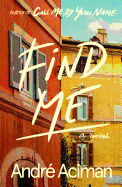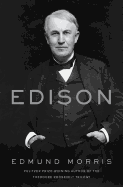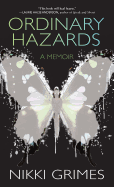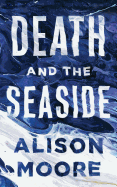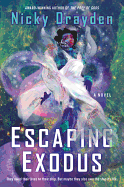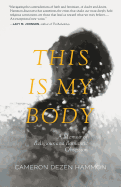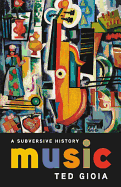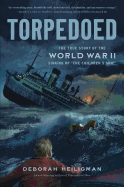Tuesday, October 29, 2019
Halloween is only two days away! Little ones picking up on the treat vibe--but who are nowhere near ready for the tricks--may enjoy some of these spooky board books.
 Rachel Matson and Joey Chou's Teeny Tiny Ghost (Cartwheel Books, $5.99) brings pre-readers into "the teeny tiny barn/ of a teeny tiny house" where two creatures live: "a teeny tiny ghost/ and a teeny tiny mouse." The teeny tiny mouse goes about its mousy business; the teeny tiny ghost works up the nerve to "cause alarm." (It turns out that teeny tiny ghosts aren't all that scary but they do make great friends.)
Rachel Matson and Joey Chou's Teeny Tiny Ghost (Cartwheel Books, $5.99) brings pre-readers into "the teeny tiny barn/ of a teeny tiny house" where two creatures live: "a teeny tiny ghost/ and a teeny tiny mouse." The teeny tiny mouse goes about its mousy business; the teeny tiny ghost works up the nerve to "cause alarm." (It turns out that teeny tiny ghosts aren't all that scary but they do make great friends.)
 In Are You My Monster? by Amanda Noll, illustrated by Howard McWilliam (Flashlight Press, $8.99, ages 0-3), a boy draws the monster he wishes lived under his bed. The monster is green and brown and has "sharp teeth, scratchy claws, and a long tail." One by one, creatively concocted, not-too-scary monsters audition for the role. When none fit all the criteria (allowing for toddlers learning colors and shapes to judge the monsters along with the boy), the young artist worries he'll never find his monster.
In Are You My Monster? by Amanda Noll, illustrated by Howard McWilliam (Flashlight Press, $8.99, ages 0-3), a boy draws the monster he wishes lived under his bed. The monster is green and brown and has "sharp teeth, scratchy claws, and a long tail." One by one, creatively concocted, not-too-scary monsters audition for the role. When none fit all the criteria (allowing for toddlers learning colors and shapes to judge the monsters along with the boy), the young artist worries he'll never find his monster.
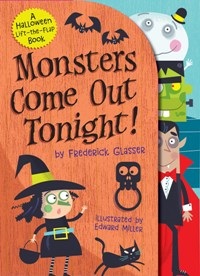 Children knock on themed lift-the-flap doors in Monsters Come Out Tonight! by Frederick Glasser, illustrated by Edward Miller (Abrams Appleseed, $8.99, ages 3-5), inviting ghosts, witches, mummies and other monsters to join them at the Monster Ball.
Children knock on themed lift-the-flap doors in Monsters Come Out Tonight! by Frederick Glasser, illustrated by Edward Miller (Abrams Appleseed, $8.99, ages 3-5), inviting ghosts, witches, mummies and other monsters to join them at the Monster Ball.
 Finally, if you know a little reader who really wants some trickery, caretakers can turn to Peek-a-Bruce by Ryan T. Higgins (Disney-Hyperion, $7.99) for children ages zero to three. The cantankerous bear, Bruce, tries to hide from his friends--in a tree, behind some rocks, under the water in a bubble bath--but the tiny geese find him everywhere. It's up to readers to decide who is doing the tricking in this amusing board book.
Finally, if you know a little reader who really wants some trickery, caretakers can turn to Peek-a-Bruce by Ryan T. Higgins (Disney-Hyperion, $7.99) for children ages zero to three. The cantankerous bear, Bruce, tries to hide from his friends--in a tree, behind some rocks, under the water in a bubble bath--but the tiny geese find him everywhere. It's up to readers to decide who is doing the tricking in this amusing board book.
--Siân Gaetano, children's and YA editor, Shelf Awareness
Find Me
by André Aciman
Catching up with one-time lovers Elio and Oliver is not, from its outset, the obvious intent of Find Me, André Aciman's hotly anticipated sequel to Call Me by Your Name, which was adapted into a popular film in 2017. Instead, this second novel chooses Elio's father, Samuel, as its reentry point into heady affairs that span tantalizing European settings. It's a decade later, and Samuel is on a train to Rome to visit his son, a professional musician, when he meets Miranda, a striking woman much younger than he. Dissatisfied with the ways love has mistreated them in the past, they bond quickly and deeply, rushing through confessions of insecurity and failings (including Samuel's marriage) into a naked, earnest hope for what could lie ahead for them both.
As a result, when Elio meets the couple the following day, he sees "a man in love. I've never seen you like this. It makes me very happy." From here, the novel picks up with Elio, years farther down the line, establishing an episodic flow reminiscent of its immediate predecessor, Enigma Variations. Still a brilliant pianist, now living in Paris, he becomes entwined with a much older man, Michel, who delights in him endlessly.
Aciman had his work cut out for himself in crafting a sequel as contemplative and gorgeous as Call Me by Your Name, which ended in its own coda of Elio's and Oliver's paths crossing years and years hence. Threading that needle, Aciman expertly delays readers' gratification. Oliver does resurface in time, but his haunting absence throughout much of the novel leaves room to explore the maturing resonance of youthful desires deferred. --Dave Wheeler, associate editor, Shelf Awareness
Discover: André Aciman's sequel to the phenomenally received Call Me by Your Name stands apart as a generous study of time's effect on desire.
Mystery & Thriller
The Man That Got Away
by Lynne Truss
Anyone intimidated by Lynne Truss's Eats, Shoots and Leaves: The Zero Tolerance Approach to Punctuation can turn to her mystery novels to enjoy word-perfect sentences minus the reproach. Along with Cat Out of Hell, there's Truss's Constable Twitten series, the second title of which is the witty and unremittingly clever The Man That Got Away.
It's July 1957 in Brighton, England, and there's a dead body on the seafront: someone has slit the throat of Peter Dupont, a 17-year-old clerk in the Sewerage and Waterworks department. On the case is young Constable Peregrine Twitten, who, as it happens, earlier that day overheard Dupont and his girlfriend talking about running away together.
The only person at the Keystone Kops-like Brighton Constabulary who can match Twitten's acumen is its charwoman, who, as he keeps trying to convince his colleagues, is really a criminal mastermind. Twitten is a look-on-the-bright-side type: "It certainly was entertaining being privy to the reactions of a callous and calculating criminal gang boss operating unsuspected in a police station." Yes, but can the woman help him solve the murder?
As diverting as it is, The Man That Got Away wouldn't meet the legal definition of a guilty pleasure. Truss gets in some good digs at the English class system, and for every trope of the mystery-horror genre that she flaunts--a wax museum, a headless torso in a suitcase--she trundles out a serious literary figure. Virginia Woolf, for one, makes the briefest, funniest, and strangest of cameos. --Nell Beram, author and freelance writer
Discover: Truss's second Constable Twitten book is a hilarious blend of mystery, farce and social commentary.
Death and the Seaside
by Alison Moore
Bonnie Falls is chronically unable to make her way in life. She left university before completing her English degree, her attempts at becoming a writer have resulted in nothing but a collection of unfinished stories, and she moves between casual work with indifference. About to turn 30, she moves out on her own for the first time, at her parents' request. In a dingy flat cluttered with abandoned possessions of previous tenants, she meets landlady Sylvia Slythe, who shares without details that she once knew Bonnie's mother, and Bonnie herself when she was a young child. Sylvia becomes interested in one of Bonnie's unfinished stories, one where a young woman in a seaside town is hounded by mysterious messages, and Bonnie is inspired to continue it. Although Bonnie says the setting is fictional, Sylvia believes she recognizes it and urges Bonnie to accompany her on a trip there to find out how the story ends.
Alison Moore (The Pre-War House and Other Stories) has crafted a taut, economical work of psychological suspense that often echoes Daphne du Maurier's Rebecca. Interrupting the main narrative with portions of Bonnie's story as well as writings that slowly reveal Sylvia's past and the deeper roots of her interest in Bonnie, Moore builds a slow burn within a brief novel that contemplates the power of stories--both the kind we read and write, and the kind we tell each other about our futures. This is an eerie, tense novel about compulsion and control that will linger with readers for far longer than the time it takes to read. --Kristen Allen-Vogel, information services librarian at Dayton Metro Library
Discover: A feckless young woman becomes subject to the manipulation of her mysterious landlady in a haunting work of psychological suspense.
The Art of Theft
by Sherry Thomas
Sherry Thomas (A Study in Scarlet Women, The Luckiest Lady in London) explores Victorian life beyond the borders of London and across the Channel in The Art of Theft, the fourth entry in the Lady Sherlock series.
Charlotte Holmes, reputation besmirched beyond repair, is no longer welcome to lead the life of a debutante in society, so she has begun a detective agency, with the help of her friend Mrs. Watson. But, alas, the Victorian era is no time for women actually to be thinking, so she is forced to solve crimes under the mantle of her fictional creation: Sherlock Holmes.
An old friend of Mrs. Watson, the mother of a maharajah, has begged the help of Sherlock Holmes in stealing a painting with scandalous secret papers hidden in its back. So Charlotte, Mrs. Watson and a retinue of assistants, including Charlotte's sister Livia and Charlotte's friend Lord Ingram, set off for France in order to attempt a daring heist. The friends soon realize that the mysterious Moriarty, who seems to have it in for Sherlock Holmes, may be involved, placing all of their lives on the line.
Quick-witted and swashbuckling, Thomas's novel is a feminist Victorian delight. Perfect for fans of Deanna Raybourn, Elizabeth Peters or C.S. Harris, The Art of Theft is an excellent entry in a wonderful historical series. Its deft pacing, quirky heroine and intriguing cast of characters make it a mysterious tour de force. --Jessica Howard, bookseller at Bookmans, Tucson, Ariz.
Discover: In this delightful novel with a Victorian setting, Charlotte Holmes, the Lady Sherlock, races to solve a mystery in a French chateau.
Science Fiction & Fantasy
Escaping Exodus
by Nicky Drayden
More than 800 years ago, humans were forced to abandon Earth on generation ships. When these ships failed to find a suitable planet, they resorted to hunting, then colonizing gargantuan space animals that skim nebulae for sustenance. But these space beasts can't survive long with human parasites. After about a decade of ruthless use, the dying animal must be left behind for a new one. All homes and most possessions are left behind--save priceless metal items--and reconstructed identically in each new beast.
Seske Kaleigh is the future leader, or Matris, of a strictly matriarchal society. To keep the population in check, family units consist of 10 people who may have only one child among them. Unfortunately for Seske, the current Matris--who is also one of Seske's mothers (in the social rather than physical sense)--betrayed their society's single-child rule by carrying her pregnancy to term after Seske was born. Thus Seske is stuck with a sister (a grave slur) who has her own leadership ambitions. As if that weren't scandalous enough, the heir apparent maintains a friendship and budding romance with Adalla, a lower-class laborer. Their dual narratives intersect and diverge to reveal a society with terrible secrets living on even less borrowed time than they think.
Nicky Drayden (The Prey of Gods; Temper) crafts a wildly imaginative work of speculative fiction with a stunning setting. The upper class enjoys the creature's comforts while workers toil endlessly, building with bone, farming the guts or maintaining vital organs. Adalla's tenure in the creature's heart, where work can be done only in the 3 minutes, 47.5 seconds between beats, is a blood-pounding highlight. Escaping Exodus is a marvelous climate change metaphor wrapped in an entertaining sci-fi story. --Tobias Mutter, freelance reviewer
Discover: In the distant future, the desperate remnants of humanity survive in moon-sized interstellar beasts.
Biography & Memoir
This Is My Body: A Memoir of Religious and Romantic Obsession
by Cameron Dezen Hammon
After converting to Christianity as a young woman, Cameron Dezen Hammon moved from New York City to Houston with Matt, the worship leader who would become her husband. Her memoir, This Is My Body, explores her efforts to reconcile the gender politics of evangelical churches with her own craving for love and affection, and her scars from past relationships with other men, including her father.
A musician and writer who immersed herself in her new faith, Hammon soon found herself singing onstage alongside Matt, then working as a worship minister for several large evangelical churches. But as she spent more time in a culture that valued women only within certain parameters, she found herself frustrated at the gentle but insistent pressure to be quiet or to defer to the men (any men) in the room. As Hammon pursues the work she loves in a context that grows ever more confining, she fights to build and sustain a life she isn't sure she wants. Her experience echoes that of many women who attempt to embrace a brand of Christianity that never fully accepts their personhood. She copes with her frustration in both healthy and unhealthy ways, including a long-distance romantic attachment and, later, a support group that sparks helpful discussions and genuine friendships. By the book's end, she is moving toward a way of believing and being that feels at once less certain and more honest. Hammon's journey will resonate with many readers who have struggled to reconcile their faith with other parts of their identities. --Katie Noah Gibson, blogger atCakes, Tea and Dreams
Discover: A new convert to Christianity wrestles with gender politics, faith and feminism in her memoir.
Edison
by Edmund Morris
In 1877, Thomas Alva Edison--already a prolific inventor, though not yet famous--decided to let his latest creation speak for itself. To the disbelief of onlookers, Edison turned on a machine consisting of a mouthpiece, cylinder, crank handle and speaker that "spoke" all by itself. In an instant, the "talking phonograph" changed everything: "Breath has been turned into metal, metal was convertible back into air," and Edison became the Wizard of Menlo Park.
In Edison, biographer Edmund Morris (winner of the National Book Award and Pulitzer Prize for The Rise of Theodore Roosevelt) chronicles the life of the inventor in reverse chronology. Morris begins with Edison in the last decade of his life--"a combination of twinkling charm and bruising imperiousness"--and finishes with his youth--an enterprising teenager who invented the two-way telegraph. In time, the most revolutionary of Edison's inventions come into focus. For instance, the first reliable incandescent light bulb and subsequent centralized lighting system were "so unobtrusive and at the same time so world changing" that the impact was inconceivable. And the Kinetograph, showing a 27-second loop of blacksmiths at work, pulled viewers "into a flickering world where Lilliputian figures moved in chiaroscuro."
Morris, who died in May 2019, clearly admired his subject, but this is no hagiography. Regarded by some as "half genius, half fool," Edison was often in dire financial straits, tussled with partners and competitors, and failed often; his family long suffered from his workaholism. But he was also charming, affable and blessed with a boundless curiosity that allowed his genius to flourish, for which the world would never be the same. --Frank Brasile, selection librarian, writer, editor
Discover: The United States' foremost inventor gets his due in this magisterial biography by the late Edmund Morris.
I Hope We Choose Love: A Trans Girl's Notes from the End of the World
by Kai Cheng Thom
"Deep down, I have always believed that I'm a bad person and that the world we live in is an awful place." The essays and poems in Kai Cheng Thom's I Hope We Choose Love forge a fiery path through the violence and negative messages the trans community simmers in. She seeks to find love--a lofty goal considering queer people, particularly queer women of color, are being murdered, dictated against and most often excluded by social norms, even within "Queerlandia." Thom's voice is one of power, her strength and ultimate hope punching through the tragedy, anger and crises of faith infusing these pieces.
Thom became "queer famous" in 2016 at age 25, when she published several works and entered the fray of social justice. She was stalked and threatened, and ultimately lost faith in her community and herself. In three parts, "Let Us Live," "Let Us Love" and "Let Us Believe," Thom calls out the fragmentation of identity politics and the "Oppression Olympics" (harsh competition for resources), asks her community to acknowledge its own culpability, and highlights the importance of family (noting, somewhat tongue-in-cheek, how babies are ruining everything).
Thom yearns for "gender euphoria," the state of finding joy rather than hatred in one's own gender presentation. The revolution starts at home and inside each of us. "What's an overachieving yet politically disenchanted, attachment-traumatized East Asian tranny who wants to survive and also be a decent person in the world supposed to do?" Thom writes unflinchingly, a marginalized voice of laudable might. --Lauren O'Brien of Malcolm Avenue Review
Discover: These evocative and forthright essays focus on the power and vulnerabilities of being an Asian trans woman in today's social warrior and queer culture.
History
Music: A Subversive History
by Ted Gioia
Musical innovation almost always comes from outcasts, Ted Gioia argues in his sweeping, persuasive Music: A Subversive History. Again and again, over the course of millennia, Gioia finds outsiders (enslaved people, shamans, women, bohemians) upsetting the powers that be with breakthroughs in technique, expression, instrumentation and frank passion. And, repeatedly, those powers, after years of resistance, assimilate the outsiders' once-verboten music to shore up their own hegemony. It's a reliable, perennial process that inspires Gioia, a shrewd and restless guide, to link the biblical adoption of the lusty Song of Songs to Richard Nixon's goofy White House meeting with Elvis Presley.
A music historian and the author of, among other titles, Love Songs and How to Listen to Jazz, Gioia here takes the longest of long views, investigating the music making of hunter-gatherer cultures and ancient fertility cults as energetically as he digs into Bach, Louis Armstrong and N.W.A. Gioia writes for a wide audience while still challenging orthodoxies and championing open minds and ears.
The narrative favors Western music but is rich with examples from around the globe. His idea of subversive extends beyond minor differences of politics or marketing categorization to encompass instead assaults upon the established order. In Gioia's history, 1980s parents' outrage at "satanic" rock music is a logical continuation of Pope Eutychius's third-century injunction against blasphemous "women's song and ring-dances." Gioia treats the pop explosion of the last century as the in-progress continuation of his cycles of cultural disruption and adoption rather than their historic endpoint. --Alan Scherstuhl, freelance writer and editor
Discover: Ted Gioia's sweeping Music: A Subversive History puts outcasts and enslaved peoples at the center of everything.
Social Science
Volume Control: Hearing in a Deafening World
by David Owen
People have traditionally done a shabby job at protecting their ears. David Owen, a 60-something tinnitus sufferer with mild hearing loss, recalls of his childhood, "We had been warned that slingshots and BB guns and darts and arrows and gym towels could blind us if we aimed them at each other's faces, but I have no memory of being similarly advised about the dangers of sound."
Volume Control: Hearing in a Deafening World is Owen's look at how society has historically treated (in both senses) the deaf, and what we are doing now to solve the problem of hearing loss. A staff writer for the New Yorker who has written more than a dozen books on a host of topics, Owen dutifully metes out the basics about the auditory system, but it's Volume Control's human-interest angle that enthralls. He discusses the ongoing controversy within the deaf community regarding surgical cures; one of Owen's many interview subjects, a tinnitus researcher with a hearing-impaired daughter, explains that some who consider their deafness part of their cultural identity believe that "cochlear implants are unnecessary--that they are solutions to a problem that doesn't exist." And Owen offers a heartbreaking riff on how military men and women, whose ears have always taken a beating, are even today given the message from higher-ups that wearing ear protection and complaining of hearing loss are signs of weakness.
Although Volume Control is inevitably cautionary, the book is not a scold. That's because Owen's curiosity rather than an agenda powers his research. --Nell Beram, author and freelance writer
Discover: This fascinating social and cultural history of hearing problems and solutions sounds notes of both caution and hope.
Children's & Young Adult
Ordinary Hazards: A Memoir
by Nikki Grimes
In her haunting memoir in verse, award-winning author and poet Nikki Grimes shares what she believes is "the most important story" she has to tell: that of her own devastatingly difficult childhood. Grimes, author of Coretta Scott King Award-winning Bronx Masquerade, as well as Between the Lines, The Watcher, Chasing Freedom and many others, is nakedly honest in Ordinary Hazards.
She works within a loosely chronological structure that begins with her birth in 1950 in Harlem and moves through the years to 1966, when her mother's mental illness escalates and her beloved though mostly absent father dies. During these years, coinciding with the civil rights movement, she and her older sister, Carol, pinball between foster homes and stints with their mother and her sexually abusive husband. At three, she and her sister are locked in a cockroach-infested closet all day, every day, by a woman their mother had hired to watch them, leading to a years-long fear of the dark. ("No one warned me/ the world was full of/ ordinary hazards/ like closets with locks and keys.") The horror of her days relents occasionally when she's in a good foster home, finds a friend or, most significantly, discovers writing at age six. For the first time, she lets her thoughts "gush like a geyser,/ shooting high into the moonless sky."
Ordinary Hazards is a gorgeous piece of writing that also serves as powerful inspiration for any reader who has struggled and sought grace. Grimes's triumph over adversity is matched only by her skill with the written word--her memoir is accessible to poetry enthusiasts and detractors alike, and will linger long after the final lines. --Emilie Coulter, freelance writer and editor
Discover: In this stunning YA memoir-in-verse, Nikki Grimes tells the harrowing story of her childhood, out of which she rose, against all odds, to become an award-winning poet and author.
Torpedoed: The True Story of the World War II Sinking of the "Children's Ship"
by Deborah Heiligman
During World War II, British families feared for the safety of their children as German bombers attacked the country. "It seemed a good bet that the children would be safer at sea than at home," so the Children's Overseas Reception Board (CORB) was created to ship children away for the duration of the war.
In September 1940, the SS City of Benares, a luxury liner used as military and CORB transport, set sail to Canada; on board with the crew and paying passengers were 90 CORB children and 10 escorts. "All the children were struck by the ship's grandeur," but what began as adventure--"It is very lovely," wrote one child to her parents, "I wish you were with us"--turned tragic when a German U-boat torpedoed the ship during a strong storm. Injuries, overturned lifeboats, drowning and exposure to cold ultimately resulted in the deaths of all but 148 of the original 406 on board. Of the 90 CORB children, only 13 survived.
In Torpedoed, award-winning children's author Deborah Heiligman (Vincent and Theo; Charles and Emma) explores a harrowing moment in history with clear, insightful prose. Using first-person sources, Heiligman follows the stories of real survivors as events unfold, making history both engaging and personal. In addition to historical documents, photographs and illustrations, Torpedoed also includes ample back matter, including a bibliography, endnotes, an "After the Voyage" section and a list of names of those lost at sea. With her dual focus on the tragedy and the bravery of its heroes, Heiligman maintains an impressive balance while illuminating human strength and resilience in extraordinary circumstances. --Jennifer Oleinik, freelance writer and editor
Discover: Deborah Heiligman's Torpedoed tells the true story of devastation and survival aboard the World War II "children's ship."


